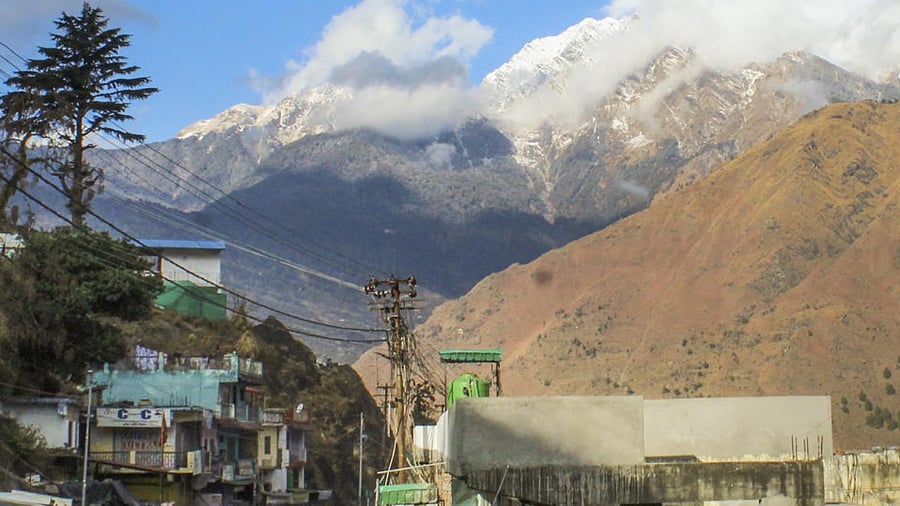
Snow-covered mountains near Joshimath in Chamoli district of Uttarakhand.
Credit: PTI Photo
The yields of pear, peach, apricot, plum, walnut and apple have markedly decreased in the last seven years due to the significant impact of global warming on Uttarakhand's horticulture, a vital economic sector contributing greatly to our national fruit basket.
The mountains, lush green valleys and undulating plains of the state with their diverse climatic conditions are ideal for the production of both temperate and subtropical fruits, but it's changing for bad.
The variations in the area of fruit production in Uttarakhand between 2016-17 and 2022-23 reveal striking shifts in cultivation patterns across different fruit types, according to a paper by Climate Trends.
Substantial reductions in certain fruit varieties over the past seven years suggest changes in agricultural strategies, land allocation, market dynamics, and possibly environmental influences affecting specific fruits.
The increase in guava and gooseberry cultivation indicates a shift in focus towards fruit types better attuned to market demand or local conditions.
“Traditional temperate crops like high-quality apples have a chilling requirement of fewer than 7 degrees Celsius for 1200-1600 hours during the period of dormancy (December-March). Apples require 2-3 times more snowfall than what the region received in the last 5-10 years leading to poor quality and yield,” said Dr Pankaj Nautiyal, Head & Senior Scientist, Horticulture, ICAR-CSSRI, Krishi Vigyan Kendra.
“Barish aur barf kaam hone se bahut hi dikkat ho rahi hain (Lack of winter snow and rain is posing a major hurdle in fruit production),” Mohan Chaubatia, a farmer from Ranikhet, was quoted saying in the research paper.
He further added that production of temperate fruits has reduced to half in the last two decades in Almora. Farmers who cannot afford irrigation have been the worst affected due to the increasingly dry winters and low fruit productivity in the state.
Uttarakhand has also been in the eye of recurring disasters ranging from extreme rainfall events, flooding, hailstorms and landslides resulting in significant damage to agricultural fields and standing crops. While warmer temperatures hinder the growth of winter fruits, farmers are shifting to tropical alternatives.
In some districts of Uttarakhand, farmers are choosing low-chilling cultivars of apples or replacing hard nut fruits like plum, peach, and apricots with tropical alternatives like kiwi and pomegranate.
There has also been experimentation with high-density cultivation of Amrapali mango in the lower hills and valleys of Uttarkashi district which generated high returns for farmers.
In 2023, 44,882 hectares of farmlands were lost to extreme weather events. Dwindling agricultural prospects have also led to widespread outmigration from the hills to the plains which could also explain the shrinking area under horticultural production.
The declining horticulture production in the state of Uttarakhand paints a dull future for a once-thriving industry.
“The short-term variability and trends in temperature are worrying and there is a need to study the long-term trends in weather variables and its relation to yield, especially, its relation with any change in crop/cropping pattern or shift in crop/cropping pattern,” said Dr Subash Nataraja, Head, Division of Agricultural Physics, ICAR-IARI, New Delhi.